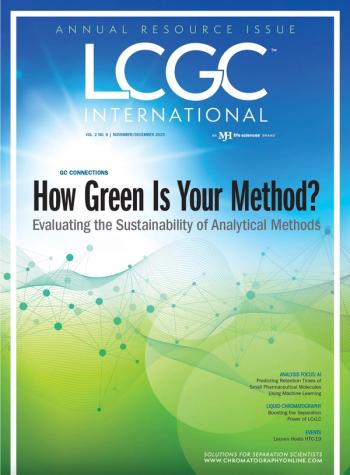
Analyzing Effects of Adverse Cardiovascular Events on Chronic Kidney Disease with HPLC
Researchers investigated the potential association between plasma apolipoprotein M (APOM) levels and the risk of adverse cardiovascular outcomes in individuals with chronic kidney disease (CKD). Plasma sphingosine-1-phosphate (S1P) levels were measured by high performance liquid chromatography (HPLC).
Based on the established anti-inflammatory and cardioprotective effects attributed to apolipoprotein M (APOM), researchers sought to determine whether reduced plasma levels of APOM may be associated with increased susceptibility to major adverse cardiovascular events (MACE) in patients with chronic kidney disease (CKD). High performance liquid chromatography (HPLC) was used to measure plasma sphingosine-1-phosphate (S1P) levels. A paper based on this research was published in Arteriosclerosis, Thrombosis, and Vascular Biology (1).
CKD impacts more than 10% of the global population, a frequency that is steadily increasing (2).Factors that are contributing to this escalation in diagnosis include the higher prevalence of type 2 diabetes, hypertension, and the aging population, as well as challenges such as limited diagnostic options and therapeutic inertia in the earlier stages of CKD (3–5). Renal disease can result in the significant disruption of lipoprotein metabolism, which leads to various lipid abnormalities (6).When CKD progresses, inflammation and oxidative stress can result; in addition, high-density lipoprotein (HDL) often reacts in a dysfunctional manner, sometimes even exhibiting proatherogenic characteristics (7–11).One of the changes in HDL related to CKD is a reduction of APOM (12), an apolipoprotein belonging to the lipocalin family and primarily secreted by the liver and kidneys (13).A large amount of research has shown the varied useful properties of APOM, including its anti-inflammatory and antiatherogenic benefits (14,15).
For the study, 463 patients diagnosed with CKD of a stage G2 to G4 variety and not yet receiving dialysis were included; plasma APOM levels were quantified using a sandwich ELISA-based assay, and plasma S1P levels were measured by HPLC. Plasma APOM levels exhibited a significant inverse association with the risk of MACE (standardized hazard ratio, 0.60 [95% CI, 0.49–0.75]; P<0.001) and all-cause mortality (standardized hazard ratio, 0.63 [95% CI, 0.48–0.83]; P<0.001). This inverse association with MACE remained robust even after adjustment for established cardiovascular and renal risk factors. The team’s findings were then confirmed by the results of an independent study involving a group of 822 patients with CKD from the Copenhagen CKD study. The S1P levels of the plasma analyzed revealed an inverse association with MACE in univariable analyses. This relationship, however, lost any statistical impact after multivariable modifications (1).
The authors believe that their findings indicate a strong link between low plasma APOM levels and a higher risk of MACE in patients with CKD, with their analysis suggesting that APOM may contribute to cardiovascular protection in this vulnerable population. Although the precise underlying mechanism remains to be fully clarified, the authors state that the anti-inflammatory and vascular-protective properties of APOM/S1P are likely contributors to this association. These findings, they conclude, may offer a promising direction for future research aimed at developing targeted therapeutic strategies to address cardiovascular complications in patients with CKD. However, they acknowledge several limitations of this study. The inclusion of a healthy control group would have allowed for more accurate comparisons, particularly in milder stages of CKD (1).
References
1. Stadler, J. T.; Borenich, A.; Stattau Bisgaard, L.; et al. ApoM and Major Adverse Cardiovascular Events in Chronic Kidney Disease: A Prospective Cohort Study. Arterioscler. Thromb. Vasc. Biol. 2025.DOI:
2. Webster, A. C.; Nagler, E. V.; Morton, R. L.; Masson, P. Chronic Kidney Disease. Lancet 2017, 389, (10075),1238–1252. DOI:
3. Thomas, M. C.; Cooper, M. E.; Zimmet, P. Changing Epidemiology of Type 2 Diabetes Mellitus and Associated Chronic Kidney Disease. Nat. Rev. Nephrol. 2016, 12 (2), 73–81. DOI:
4. Nissenson, A. R.; Collins, A. J.; Hurley, J.; et al. Opportunities for Improving the Care of Patients with Chronic Renal Insufficiency: Current Practice Patterns. J. Am. Soc. Nephrol. 2001, 12 (8), 1713–1720. DOI:
5. Jankowski, J.; Floege, J.; Fliser, D.; Böhm, M.; Marx, N. Cardiovascular Disease in Chronic Kidney Disease: Pathophysiological Insights and Therapeutic Options. Circulation 2021, 143 (11), 1157–1172. DOI:
6. Marsche, G.; Heine, G. H.; Stadler, J. T.; Holzer, M. Current Understanding of the Relationship of HDL Composition, Structure and Function to Their Cardioprotective Properties in Chronic Kidney Disease. Biomolecules 2020, 10 (9),1348. DOI:
7. Holzer, M.; Birner-Gruenberger, R.; Stojakovic, T.; et al. Uremia Alters HDL Composition and Function. J. Am. Soc. Nephrol. 2011, 22 (9),1631–41. DOI:
8. Weichhart, T.; Kopecky, C.; Kubicek, M.; et al. Serum Amyloid A in Uremic HDL Promotes Inflammation. J. Am. Soc. Nephrol. 2012, 23 (5), 934–947. DOI:
9. Holzer, M.; Schilcher, G.; Curcic, S.; et al. Dialysis Modalities and HDL Composition and Function. J. Am. Soc. Nephrol. 2015, 26 (9), 2267–2276. DOI:
10. Anderson, J. L.; Gautier, T.; Nijstad, N.; et al. High Density Lipoprotein (HDL) Particles from End-Stage Renal Disease Patients Are Defective in Promoting Reverse Cholesterol Transport. Sci. Rep. 2017, 7, 41481. DOI:
11. Shroff, R.; Speer, T.; Colin, S.; et al. HDL in Children with CKD Promotes Endothelial Dysfunction and an Abnormal Vascular Phenotype. J. Am. Soc. Nephrol. 2014, 25 (11), 2658–2668. DOI:
12. Sørensen, I. M.; Bertelsen, M.; Freese, E.; et al. Apolipoprotein M in Patients with Chronic Kidney Disease. Atherosclerosis 2018, 275, 304–311. DOI:
13. Duan, J.; Dahlbäck, B.; Villoutreix, B. O. Proposed Lipocalin Fold for Apolipoprotein M Based on Bioinformatics and Site-Directed Mutagenesis. FEBS Lett. 2001, 499 (1–2), 127–132. DOI:
14. Christoffersen, C.; Nielsen, L. B.; Axler, O.; et al. Isolation and Characterization of Human Apolipoprotein M-Containing Lipoproteins. J. Lipid Res. 2006, 47 (8), 1833–1843. DOI:
15. Christoffersen, C.; Obinata, H.; Kumaraswamy, S. B.; et al. Endothelium-Protective Sphingosine-1-Phosphate Provided by HDL-Associated Apolipoprotein M. Proc. Natl. Acad. Sci. USA 2011,108 (23), 9613–9618. DOI:
Newsletter
Join the global community of analytical scientists who trust LCGC for insights on the latest techniques, trends, and expert solutions in chromatography.



